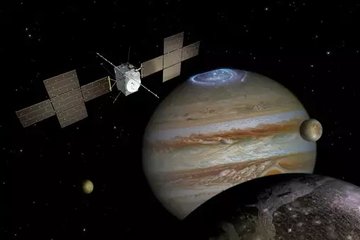JUICE’s JEI-sensor:
First stop on the way to Jupiter
The sensor, which was developed and built at MPS, has arrived in Bern. There the next phase of preparations for ESA's Jupiter mission will begin.
The sensor JEI (Jovian Electron and Ion Sensor), which will from 2029 onwards study the distribution of high-energetic electrons and ions in the Jovian system on board ESA's JUICE (Jupiter Icy Moon Explorer) spacecraft, has been completed. JUICE is scheduled to be launched in 2022, but JEI's journey has already begun. Yesterday, the sensor, which has been developed, built, and tested at the Max Planck Institute for Solar System Research (MPS) in Germany over the past three years, arrived at the University of Bern (Switzerland). Earlier this month, MPS employees had already delivered the associated electronics box there. In the department "Space Research & Planetary Sciences" of the Institute of Physics, JEI will now be integrated with other sensors of the instrument package PEP (Particle Environment Package).

PEP consists of two units (PEP-Lo and PEP-Hi) with a total of six sensors, each of which specializes in measurements of charged and neutral particles of different energies in the vicinity of Jupiter. Over the next few months, four of the six individual sensors will be integrated in Bern to form the unit PEP-Lo. Among other things, it must be ensured that the sensors do not interfere with each other during their measurements thus falsifying results. After successful completion, PEP-Lo (and with it JEI) will travel on to Airbus in Friedrichshafen (Germany), where the unit will be integrated into the space probe.
By far the largest part of the journey to Jupiter will begin in May 2022, when JUICE will lift off into space carrying eleven scientific instruments on board. It will take the probe seven years to reach the Jovian system. Scientists are mainly interested in some of the giant planet’s icy moons. The Galilean moons Ganymede, Callisto and Europa, for example, are rocky worlds, some of them larger than or similar in size to Mercury. In addition, some of them show evidence of subsurface water and an internal magnetic field that protects the respective moon from the influences of outer space. Characterizing this magnetic field and investigating the interactions between planet and moons is one of PEP’s scientific goals.

In the past, MPS has contributed hardware to several space missions to the gas giants Jupiter and Saturn. For example, the MIMI-LEMMS (Magnetosphere Imaging Instrument - Low Energy Magnetospheric Measurement System) particle sensor spent 13 years on board NASA's Cassini spacecraft exploring the Saturnian system. Nevertheless, JEI is a completely new development. The conditions that await the sensor in the Jovian system differ significantly from those in the vicinity of Saturn.
After the successful handover in Bern, work continues for the scientists and engineers at MPS. The so-called JEI flight spare unit is now being built there. The identical twin of the flight unit will remain on the ground during the mission and serve as a valuable reference to better understand the measurement data and behavior of JEI.













